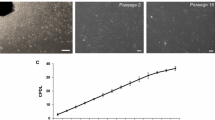Abstract
Stem cells play a crucial role in maintaining and repairing tissues during homeostasis and following injury. The efficient procurement of high quantity and quality of skin stem cells is important for both laboratory studies and clinical applications. Here, we describe a one-step isolation procedure to efficiently obtain both epidermal and dermal cell population from human skin specimen, based on the different influence of the Rho kinase inhibitor Y27632 on the growth of epidermal and dermal cells during the initial culture. Compared with the conventional methods, our protocol shows that it is simpler and less time consuming and can efficiently obtain the high quality of skin stem cells and can maintain the stem cell features after culture expansion.
Access this chapter
Tax calculation will be finalised at checkout
Purchases are for personal use only
Similar content being viewed by others
References
Prodinger CM, Reichelt J, Bauer JW, Laimer M (2017) Current and future perspectives of stem cell therapy in dermatology. Ann Dermatol 29(6):667–687
Gonzales KAU, Fuchs E (2017) Skin and its regenerative powers: an alliance between stem cells and their niche. Dev Cell 43(4):387–401. https://doi.org/10.1016/j.devcel.10.001
Hirsch T, Rothoeft T, Teig N, Bauer JW, Pellegrini G, De Rosa L, Scaglione D, Reichelt J, Klausegger A, Kneisz D, Romano O, Secone Seconetti A, Contin R, Enzo E, Jurman I, Carulli S, Jacobsen F, Luecke T, Lehnhardt M, Fischer M, Kueckelhaus M, Quaglino D, Morgante M, Bicciato S, Bondanza S, De Luca M (2017) Regeneration of the entire human epidermis using transgenic stem cells. Nature 551(7680):327–332
Terunuma A, Limgala RP, Park CJ, Choudhary I, Vogel JC (2010) Efficient procurement of epithelial stem cells from human tissue specimens using a rho-associated protein kinase inhibitor Y-27632. Tissue Eng A 16(4):1363–1368. https://doi.org/10.1089/ten.TEA.2009.0339
Aasen T, Izpisua Belmonte JC (2010) Isolation and cultivation of human keratinocytes from skin or plucked hair for the generation of induced pluripotent stem cells. Nat Protoc 5(2):371–382. https://doi.org/10.1038/nprot.2009.241
Zou D, Pan J, Zhang P, Wu X (2016) A new method to isolate human epidermal keratinocytes. J Clin Dermatol 6:424–429. (in Chinese)
Wen J, Zu T, Zhou Q, Leng X, Wu X (2017) Y-27632 simplifies the isolation procedure of human primary epidermal cells by selectively blocking focal adhesion of dermal cells. J Tissue Eng Regen Med. https://doi.org/10.1002/term.2526
Zhou Q, Zhang Q, Leng X, Zu T, Qin J, Wen J, Wu X (2017) Culture-expanded adult dermal cells derived from scalp tissue are multi- differentiation potential. Smart healthcare, 3(3):1-8 DOI:https://doi.org/10.19335/j.cnki.2096., (in chinese)
Watt FM (1998) Epidermal stem cells: markers, patterning and the control of stem cell fate. Philos Trans R Soc Lond B Biol Sci 353(1370):831–837. https://doi.org/10.1098/rstb.1998.0247
Barrandon Y, Green H (1987) Three clonal types of keratinocyte with different capacities for multiplication. Proc Natl Acad Sci U S A 84(8):2302–2306
Chen S, Lewallen M, Xie T (2013) Adhesion in the stem cell niche: biological roles and regulation. Development 140(2):255–265. https://doi.org/10.1242/dev.083139
Bartsch G, Yoo JJ, De Coppi P, Siddiqui MM, Schuch G, Pohl HG, Fuhr J, Perin L, Soker S, Atala A (2005) Propagation, expansion, and multilineage differentiation of human somatic stem cells from dermal progenitors. Stem Cells Dev 14(3):337–348. https://doi.org/10.1089/scd.2005.14.337
Chen FG, Zhang WJ, Bi D, Liu W, Wei X, Chen FF, Zhu L, Cui L, Cao Y (2007) Clonal analysis of nestin(−) vimentin(+) multipotent fibroblasts isolated from human dermis. J Cell Sci 120(Pt 16):2875–2883. https://doi.org/10.1242/jcs.03478
Acknowledgement
This work was supported by National Key Research and Development Program of China (2017YFA0104604), General Program of National Natural Science Foundation of China (81772093), and Shandong Taishan Scholar Award (tshw201502065).
Author information
Authors and Affiliations
Corresponding author
Editor information
Editors and Affiliations
Rights and permissions
Copyright information
© 2018 Springer Science+Business Media New York
About this protocol
Cite this protocol
Qian, H., Leng, X., Wen, J., Zhou, Q., Xu, X., Wu, X. (2018). One-Step Simple Isolation Method to Obtain Both Epidermal and Dermal Stem Cells from Human Skin Specimen. In: Turksen, K. (eds) Skin Stem Cells. Methods in Molecular Biology, vol 1879. Humana Press, New York, NY. https://doi.org/10.1007/7651_2018_117
Download citation
DOI: https://doi.org/10.1007/7651_2018_117
Published:
Publisher Name: Humana Press, New York, NY
Print ISBN: 978-1-4939-8869-3
Online ISBN: 978-1-4939-8870-9
eBook Packages: Springer Protocols



